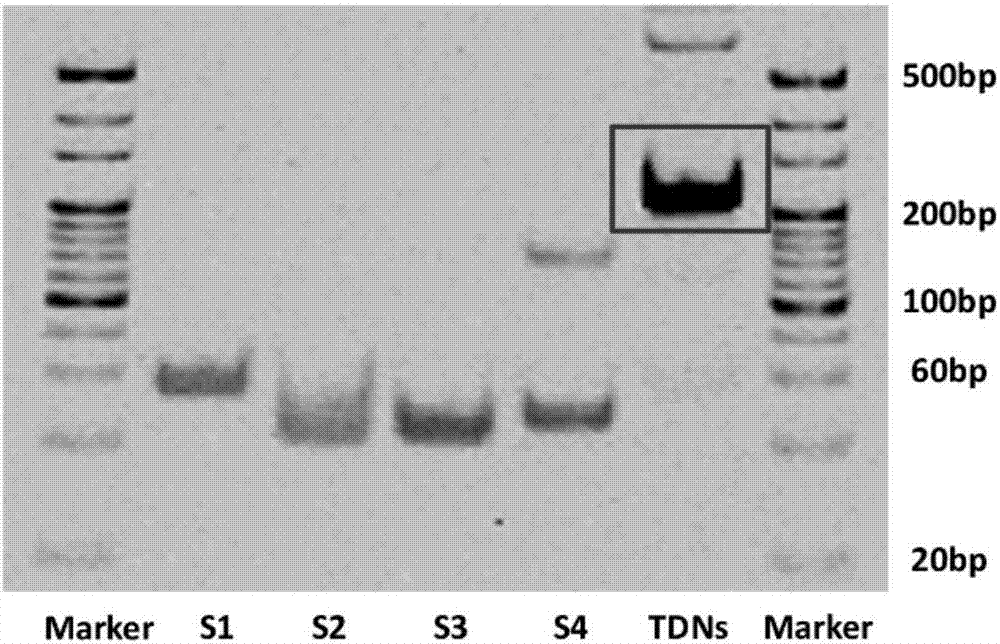Application of DNA tetrahedron in the aspect of improving anti-aging process of cells
A tetrahedral, anti-aging technology, used in medical preparations containing active ingredients, anti-inflammatory agents, anti-toxic agents, etc., to achieve good bioavailability, delay aging, and inhibit expression.
- Summary
- Abstract
- Description
- Claims
- Application Information
AI Technical Summary
Problems solved by technology
Method used
Image
Examples
Embodiment 1
[0031] Synthesis and characterization of embodiment 1 DNA tetrahedron
[0032] 1. Synthesis of DNA tetrahedron
[0033] Add the four specially designed single strands of the DNA tetrahedron into a 200μl EP tube containing 100ul TM buffer (10mMTris-HCl, 50mM MgCl2, pH 8.0) in an equimolar ratio, and then maintain the mixed system at 95°C for 10min, then rapidly cool down Keep it at 4°C for 20 minutes to synthesize a DNA tetrahedron, which can be stored at 4°C for a long time.
[0034] The specific sequences of the four DNA single strands are as follows:
[0035] S1:
[0036] 5'-ATTTATTCACCCGCCATAGTAGACGTATCACCAGGCAGTTGAGACGAACATTCCTAAGTCTGAA-3' (SEQ ID NO: 1);
[0037] S2:
[0038] 5'-ACATGCGAGGGTCCAATACCGACGATTACAGCTTGCTACACGATTCAGACTTAGGAATGTTCG-3' (SEQ ID NO: 2);
[0039] S3:
[0040] 5'-ACTACTATGGCGGGTGATAAAACGTGTAGCAAGCTGTAATCGACGGGAAGAGCATGCCCATCC-3' (SEQ ID NO: 3);
[0041] S4:
[0042] 5'-ACGGTATTGGACCCTCGCATGACTCAACTGCCTGGTGATACGAGGATGGGCATGCTCTTCCCG-3' (SEQ ID...
Embodiment 2G
[0048] Example 2 Griess method to detect the influence of DNA tetrahedron on secretion of inflammatory factor NO by inflammatory model cells
[0049]The biological effects of NO depend on its concentration and subtle changes inside and outside cells. Under normal physiological conditions, a small amount of NO is beneficial to the body. However, high concentrations of NO can cause tissue damage, malignancy, rheumatoid arthritis, and septic shock. To investigate whether TDNs play a role in inflammatory response, we treated RAW264.7 cells with lipopolysaccharide (LPS) to establish an inflammatory response model. Production of the inflammatory mediator NO was examined by Griess assay.
[0050] Experimental method: The experiment is divided into four groups, namely: negative control group, positive control group, experimental group 1, and experimental group 2.
[0051] First, RAW264.7 cells were inoculated in 96-well cell culture plates, cultured in medium containing 10% FBS for...
Embodiment 3
[0053] Example 3 Study on the anti-inflammatory mechanism of DNA tetrahedron on RAW264.7 cells
[0054] Endogenous NO is mainly derived from L-arginine, and three isoenzymes can convert L-arginine to L-citrulline and NO, namely, neuronal NO synthase, endothelial NO synthase, and inducible NO synthase (iNOS)31,32. iNOS is widely distributed in the human body, especially in macrophages, hepatocytes, astrocytes and smooth muscle cells. Therefore, we further explored the effects of TDNs on iNOS levels by detecting the expression of iNOS gene and protein by confocal microscopy, Western Blotting, and fluorescent quantitative PCR.
[0055] experiment method:
[0056] (1) The experiment is divided into four groups, namely: negative control group, positive control group, experimental group 1, and experimental group 2.
[0057] First, RAW264.7 cells were seeded in 96-well cell culture plates and cultured in 10% FBS at 37°C, 5% CO 2 Cultivate in the incubator for 8h, then change to t...
PUM
 Login to View More
Login to View More Abstract
Description
Claims
Application Information
 Login to View More
Login to View More - R&D
- Intellectual Property
- Life Sciences
- Materials
- Tech Scout
- Unparalleled Data Quality
- Higher Quality Content
- 60% Fewer Hallucinations
Browse by: Latest US Patents, China's latest patents, Technical Efficacy Thesaurus, Application Domain, Technology Topic, Popular Technical Reports.
© 2025 PatSnap. All rights reserved.Legal|Privacy policy|Modern Slavery Act Transparency Statement|Sitemap|About US| Contact US: help@patsnap.com



